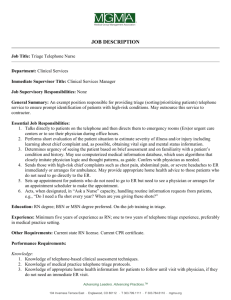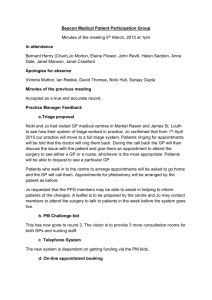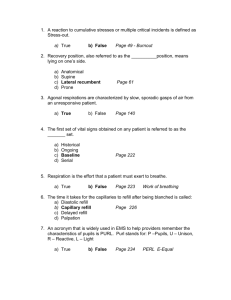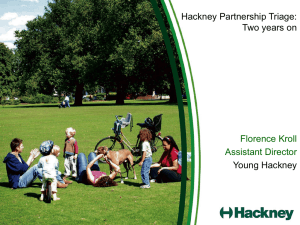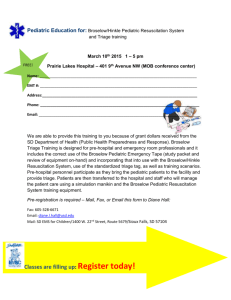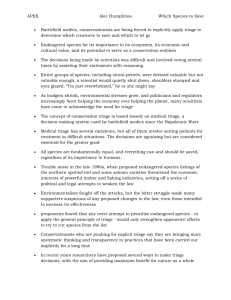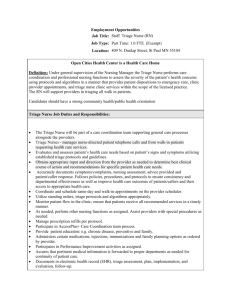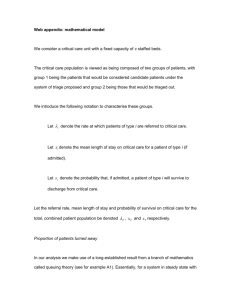Triage and Pre-Hospital Treatment
advertisement
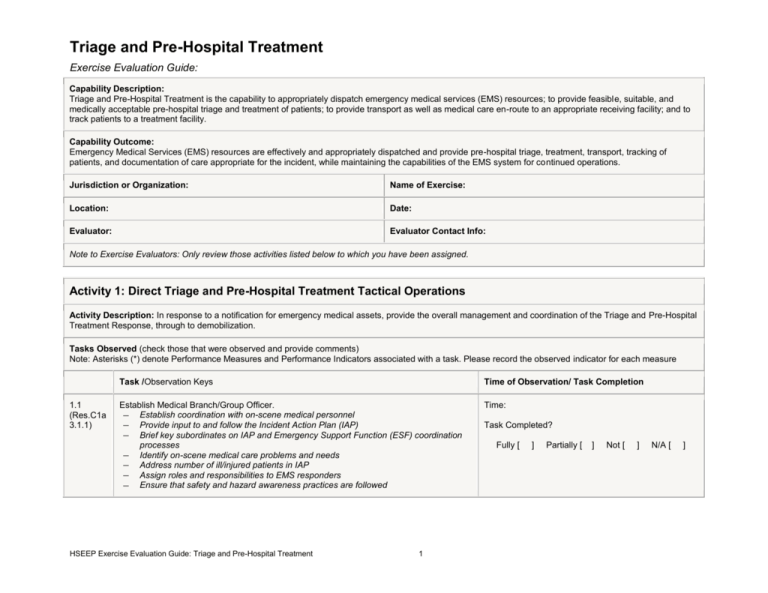
Triage and Pre-Hospital Treatment Exercise Evaluation Guide: Capability Description: Triage and Pre-Hospital Treatment is the capability to appropriately dispatch emergency medical services (EMS) resources; to provide feasible, suitable, and medically acceptable pre-hospital triage and treatment of patients; to provide transport as well as medical care en-route to an appropriate receiving facility; and to track patients to a treatment facility. Capability Outcome: Emergency Medical Services (EMS) resources are effectively and appropriately dispatched and provide pre-hospital triage, treatment, transport, tracking of patients, and documentation of care appropriate for the incident, while maintaining the capabilities of the EMS system for continued operations. Jurisdiction or Organization: Name of Exercise: Location: Date: Evaluator: Evaluator Contact Info: Note to Exercise Evaluators: Only review those activities listed below to which you have been assigned. Activity 1: Direct Triage and Pre-Hospital Treatment Tactical Operations Activity Description: In response to a notification for emergency medical assets, provide the overall management and coordination of the Triage and Pre-Hospital Treatment Response, through to demobilization. Tasks Observed (check those that were observed and provide comments) Note: Asterisks (*) denote Performance Measures and Performance Indicators associated with a task. Please record the observed indicator for each measure 1.1 (Res.C1a 3.1.1) Task /Observation Keys Time of Observation/ Task Completion Establish Medical Branch/Group Officer. ― Establish coordination with on-scene medical personnel ― Provide input to and follow the Incident Action Plan (IAP) ― Brief key subordinates on IAP and Emergency Support Function (ESF) coordination processes ― Identify on-scene medical care problems and needs ― Address number of ill/injured patients in IAP ― Assign roles and responsibilities to EMS responders ― Ensure that safety and hazard awareness practices are followed Time: HSEEP Exercise Evaluation Guide: Triage and Pre-Hospital Treatment 1 Task Completed? Fully [ ] Partially [ ] Not [ ] N/A [ ] Time to provide medical coordination of on-scene emergency medical services (EMS) system personnel and other health resources TARGET ACTUAL IAW federal, state, or local policy; in absence of policy: report time plus one hour Time to provide medical coordination of public health services, hospitals, and healthcare providers TARGET ACTUAL IAW federal, state, or local policy; in absence of policy: report time plus one hour 1.2 (Res.C1a 3.1) Coordinate with on-scene Incident Command. ― Obtain briefing from Incident Command (IC) or appropriate authority ― Report limiting medical care, personnel, and/or equipment factors to IC ― Maintain ongoing coordination with IC for medical personnel and equipment needs Time: Task Completed? Fully [ 1.3 (Res.C1a 3.2 ) Ensure effective, reliable interoperable communications between providers, medical command, public health, and health care facilities. ― Identify operational radio channels ― Establish contact with other ESF liaisons as necessary ― Ensure that on-scene communication procedures are established ― Ensure that on-scene equipment checks are completed ] Partially [ ] Not [ ] N/A [ ] ] Not [ ] N/A [ ] Time: Task Completed? Fully [ Time to establish primary communication with on-scene personnel and ESF liaison contacts ] Partially [ TARGET ACTUAL IAW federal, state, or local policy; in absence of policy: report time plus one hour 1.4 (Res.C1a 3.3.2 ) 1.5 (Res.C1a 3.3.3 ) Assess need for additional medical resources/mutual aid. ― Coordinate with IC on projected needs ― Coordinate with EMS responders on status and capacity ― Identify mutual aid (local jurisdictional and EMAC) capacity and availability ― Continually re-assess on-scene medical needs Time: Initiate recall and/or mutual aid to staff spare ambulances and provide immediate surge capability. ― Identify personnel to recall ― Execute recall procedures ― Identify spare transport units ― Request mutual aid from jurisdictional and/or EMAC sources, if needed ― Coordinate with the logistics cell (or equivalent entity) Time: HSEEP Exercise Evaluation Guide: Triage and Pre-Hospital Treatment 2 Task Completed? Fully [ ] Partially [ ] Not [ ] N/A [ ] ] Not [ ] N/A [ ] Task Completed? Fully [ ] Partially [ Time to execute recall and mutual aid agreements (MAA) with State and local partners TARGET ACTUAL IAW federal, state, or local policy; in absence of policy: mutual need identified time plus one hour 1.6 (Res.C1a 3.3.4.1) 1.7 (Res.C1a 3.3.4.2 ) Implement and maintain accountability procedures for EMS personnel, equipment, and supplies. ― Establish check-in procedure(s) for responding units and personnel ― Ensure that all medical responders use PPE as appropriate for on-scene hazards ― Coordinate with Law Enforcement (LE)/Hazardous Materials (HAZMAT)/ Firefighting Operations ― Complete documentation IAW local procedures Time: Provide medical support and safety considerations. ― Coordinate with IC ― Identify medical supply, resource, and equipment needs ― Coordinate with logistics cell (or equivalent entity) to procure needed supplies ― Identify on-scene medical refreshment and food needs for rescuers Time: Task Completed? Fully [ ] Partially [ ] Not [ ] N/A [ ] ] Not [ ] N/A [ ] Task Completed? Fully [ Time to organize and make special safety equipment accessible to all on-scene medical personnel ] Partially [ TARGET ACTUAL IAW federal, state, or local policy; in absence of policy: need identified time plus one hour Identify the number of an describe any unsafe practices seen on-scene or in the coordination center/cell TARGET ACTUAL No unsafe practices seen 1.8 (Res.C1a 3.3.1 ) Organize and distribute medical resources. ― Assess availability of on-scene unit-level medical equipment ― Collect non-committed essential medical supplies and equipment ― Establish medical supply and equipment resource area(s ― Develop a medical equipment inventory list(s) ― Complete appropriate documentation Time: Task Completed? Fully [ Time to ensure sufficient and appropriate medical equipment and supplies are readily available to on-scene personnel ] Partially [ TARGET IAW federal, state, or local policy; in absence of policy: report time plus two hours HSEEP Exercise Evaluation Guide: Triage and Pre-Hospital Treatment 3 ] Not [ ] N/A [ ACTUAL ] Activity 2: Activate Triage and Pre-Hospital Treatment Activity Description: In response to a notification, respond, mobilize, and arrive on-scene to begin emergency medical operations. Tasks Observed (check those that were observed and provide comments) Note: Asterisks (*) denote Performance Measures and Performance Indicators associated with a task. Please record the observed indicator for each measure 2.1 (Res.C1a 4.1 ) Task /Observation Keys Time of Observation/ Task Completion Dispatch and support medical care personnel. ― Coordination between incident call taker(s) and dispatcher(s) ― Alert initial resources ― Coordinate communication requests for additional resources ― Convey hazard information to on-scene medical responders ― Complete communication equipment checks Time: Task Completed? Fully [ Time for EMS responders to be notified and dispatched to the scene ] Partially [ ] Not [ TARGET ] N/A [ ] ACTUAL IAW federal, state, or local policy; in absence of policy: within 5-10 minutes 2.2 (Res.C1a 4.2) Complete scene survey. ― Survey incident scene ― Complete appropriate circle check of immediate scene ― Identify and coordinate mitigation of on-scene hazards Time: Task Completed? Fully [ 2.3 (Res.C1a 4.2.1 ) 2.4 (Res.C1a 4.3) Establish scene safety, based on the type and severity of the incident. ― Coordinate with the on-scene Safety Officer ― Implement safety precautions ― Identify potential security needs and report them to IC or law enforcement (LE) representatives ― Coordinate with LE representatives Time: Establish triage, treatment, and transport areas. ― Identify location(s) of each area of responsibility ― Identify and coordinate resource and personnel needs with IC and/or ESF liaison ― Identify and communicate safety concerns to IC and/or ESF liaison ― Identify and communicate the location of areas that are not accessible to IC and/or ESF liaison Time: HSEEP Exercise Evaluation Guide: Triage and Pre-Hospital Treatment 4 ] Partially [ ] Not [ ] N/A [ ] ] Not [ ] N/A [ ] ] Not [ ] N/A [ ] Task Completed? Fully [ ] Partially [ Task Completed? Fully [ ] Partially [ Activity 3: Triage Activity Description: Once on-scene, provide initial and ongoing emergency medical triage of ill and injured patients that prioritizes their respective treatment and transport. Tasks Observed (check those that were observed and provide comments) Note: Asterisks (*) denote Performance Measures and Performance Indicators associated with a task. Please record the observed indicator for each measure 3.1 (Res.C1a 5.1 ) Task /Observation Keys Time of Observation/ Task Completion Conduct initial and on-going pre-hospital triage in accordance with a jurisdiction’s existing plans and procedures and prescribed triage methodology (e.g., Simple Triage and Rapid Treatment (START) Triage). ― Coordinate with Medical Branch/Group Command/Tactical Operations ― Assess triage needs and report to Tactical Operations ― Follow the strategy developed by Tactical Operations ― Assign triage teams to assess patients ― Address life-threatening issues ― Document the priority of patient(s) Time: Task Completed? Fully [ Time to initiate triage of ill/injured patients ] Partially [ ] Not [ TARGET ] N/A [ ] ACTUAL IAW federal, state, or local policy; in absence of policy: within 30 minutes 3.2 (Res.C1a 5.2 ) Initiate a patient tracking system. ― Use triage tags ― Document status and location of patients ― Request additional triage tags as needed ― Communicate patient tracking information to Medical Branch/Group Command Time: Task Completed? Fully [ Time to initiate a patient tracking system ] Partially [ ] Not [ TARGET ] N/A [ ] ACTUAL IAW federal, state, or local policy; in absence of policy: within 30 minutes 3.3 (Res.C1a 5.4) Move patients to safe, secure, and easily accessible treatment area(s). ― Coordinate with Medical Branch/Group Command/Tactical Operations ― Coordinate with Treatment Area(s) ― Consider patient priority in sequencing patient movement ― Safely move patients HSEEP Exercise Evaluation Guide: Triage and Pre-Hospital Treatment Time: Task Completed? Fully [ 5 ] Partially [ ] Not [ ] N/A [ ] Activity 4: Provide Treatment Activity Description: Provide medical treatment appropriate to the patient’s injuries and the incident. Tasks Observed (check those that were observed and provide comments) Note: Asterisks (*) denote Performance Measures and Performance Indicators associated with a task. Please record the observed indicator for each measure 4.1 (Res.C1a 6.1) 4.2 (Res.C1a 6.2 ) Task /Observation Keys Time of Observation/ Task Completion Establish Immediate, Minor, and Delayed Treatment areas. ― Coordinate with Medical Branch/Group Command/Tactical Operations ― Clearly mark and identify each treatment area ― Assign treatment teams by area ― Teams report number of ill/injured patients by area Time: Provide treatment appropriate to the nature of incident and number of injured/ill. ― Re-assess patients ― Treat patients based upon the medical priority or their signs and symptoms ― Follow established protocols ― Document patient treatment on triage tags ― Request additional medical supplies and equipment as needed ― Coordinate on-line medical control Time: Task Completed? Fully [ ] Partially [ ] Not [ ] N/A [ ] ] Not [ ] N/A [ ] Task Completed? Fully [ Time that ill/injured patients receive initial treatment by appropriately credentialed on-scene medical personnel ] Partially [ TARGET ACTUAL IAW federal, state, or local policy; in absence of policy: within 30 minutes Time to initiate coordination of patient treatment with on-line medical control TARGET ACTUAL IAW federal, state, or local policy; in absence of policy: within one hour 4.3 (Res.C1a 6.2.2 ) Provide ongoing pain management therapy as needed to victims awaiting transport. ― Coordinate with Medical Control ― Follow established medical protocols ― Comfort and re-assure patient(s) ― Re-assess patient(s) ― Document provided therapy HSEEP Exercise Evaluation Guide: Triage and Pre-Hospital Treatment 6 Time: Task Completed? Fully [ ] Partially [ ] Not [ ] N/A [ ] 4.4 (Res.C1a 6.3) Ensure documentation of patient care and transfer, in accordance with mass casualty protocols. ― Identify and document nature of illness/injury ― Identify and document priority of the patient ― Obtain and document an accurate patient history Time: Task Completed? Fully [ ] Partially [ ] Not [ ] N/A [ ] Activity 5: Transport Activity Description: Transport ill and injured patients via the most appropriate mode of transport available (e.g., ambulances, helicopters, etc.), provide ongoing medical assessment and treatment en route to the designated receiving facility, and upon arrival transfer medical care of the patient(s) to the receiving facility’s staff. Tasks Observed (check those that were observed and provide comments) Note: Asterisks (*) denote Performance Measures and Performance Indicators associated with a task. Please record the observed indicator for each measure 5.1 (Res.C1a 7.1 ) Task /Observation Keys Time of Observation/ Task Completion Identify transport vehicles, victims, and priority of transport. ― Coordinate with Medical Branch/Group Command/Tactical Operations ― Coordinate with Triage and Treatment areas ― Coordinate with Emergency Dispatch ― Assess transportation requirements and needs ― Maintain an inventory of available on-scene transport units Time: Task Completed? Fully [ Time to transport patients in vehicles appropriate to each patient's conditions and the nature and magnitude of the incident ] Partially [ ] Not [ TARGET ] N/A [ ] ACTUAL IAW federal, state, or local policy; in absence of policy: within 2 hours 5.2 (Res.C1a 7.1.1) 5.3 (Res.C1a 7.2 ) Provide for alternative modes of transport should air or other operations be necessary (e.g., helicopters along with a corresponding landing zone (LZ)). ― Coordinate with Medical Branch/Group Command/Tactical Operations ― Arrange patient transport to helicopter LZ, if needed ― Identify and request alternative transport units as needed (e.g., all-terrain vehicles (ATVs), brush trucks, boats, Coast Guard units, etc.) Time: Coordinate and transport patients to the appropriate treatment facility. ― Coordinate with receiving hospitals ― Identify hospital capabilities ― Assess and use safe and clear transport unit routes for egress and ingress ― Assign ambulance transport designations ― Load patient(s) ― Track and document patient(s) transport Time: HSEEP Exercise Evaluation Guide: Triage and Pre-Hospital Treatment 7 Task Completed? Fully [ ] Partially [ ] Not [ ] N/A [ ] ] Not [ ] N/A [ ] Task Completed? Fully [ ] Partially [ Time to initiate coordination of patient transportation with appropriate treatment facility TARGET ACTUAL IAW federal, state, or local policy; in absence of policy: within 30 minutes 5.4 (Res.C1a 7.2.1 ) Provide ongoing assessment and treatment en route. ― Follow established medical protocols ― Update receiving hospital on patient's status as necessary ― Document ongoing treatment Time: Task Completed? Fully [ 5.5 (Res.C1a 7.2.2 ) Transfer care of the patient to the medical staff at the facility. ― Safely unload patient(s) ― Provide the medical staff with a face-to-face report on the patient's status, history, and treatment ― Provide a written copy of medical report to medical staff as appropriate ] Partially [ ] Not [ ] N/A [ ] ] Not [ ] N/A [ ] Time: Task Completed? Fully [ ] Partially [ Activity 6: Demobilize Activity Description: Upon completion of duties, clear the incident scene, reconstitute as appropriate, and return to service or end duty tour. Tasks Observed (check those that were observed and provide comments) Note: Asterisks (*) denote Performance Measures and Performance Indicators associated with a task. Please record the observed indicator for each measure 6.1 (Res.C1a 8.1.1) Task /Observation Keys Time of Observation/ Task Completion Reconstitute personnel and equipment. ― Identify meeting point(s) to conduct final personnel accountability procedures ― Retrieve equipment ― Inventory equipment and document losses Time: Task Completed? Fully [ 6.2 (Res.C1a 8.1.2) Participate in incident debriefing. ― Document mission issues and accomplishments ― Brief the plan to return to the prior readiness state to personnel ― Discuss General Incident Stress Management strategies ] Partially [ ] Not [ ] N/A [ ] ] Not [ ] N/A [ ] Time: Task Completed? Fully [ ] Partially [ Triage and pre-hospital personnel debriefed Yes [ HSEEP Exercise Evaluation Guide: Triage and Pre-Hospital Treatment 8 ] No [ ] 6.3 (Res.C1a 8.3.1) Identify responder needs dependent upon their level of involvement and/or hours committed to the incident. ― Provide Critical Incident Stress Management (CISM) services to those responders identified in the debriefings, or subsequent to the debriefings ― Identify time-off needs for responders, and their families in the event they are directly affected by the incident Time: Task Completed? Fully [ ] Partially [ ] Not [ ] N/A [ ] Triage and pre-hospital personnel restored to normal or original operations Yes [ ] No [ ] Activity 7: Special Threats and Duties Activity Description: This activity highlights tasks that require special planning, analysis, and procedures in order for medical personnel to safely conduct their operations in a high or special threat condition. Tasks Observed (check those that were observed and provide comments) Note: Asterisks (*) denote Performance Measures and Performance Indicators associated with a task. Please record the observed indicator for each measure 7.1 (n/a) Task /Observation Keys Time of Observation/ Task Completion Direct triage and pre-hospital treatment tactical operations (develop procedures for handling patients, health care receivers, and property). Time: Task Completed? Fully [ Time to organize, deliver, and issue personal protective equipment (PPE) to all on-scene medical personnel ] Partially [ TARGET ] Not [ ] N/A [ ACTUAL IAW federal, state, or local policy; in absence of policy: need identified time plus 60 minutes Time to provide handling procedures to all on-scene medical personnel TARGET IAW federal, state, or local policy; in absence of policy: need identified time plus 60 minutes HSEEP Exercise Evaluation Guide: Triage and Pre-Hospital Treatment 9 ACTUAL ] 7.2 (n/a) 7.3 (n/a) Provide triage (ensure decontamination of patients prior to treatment and transport). ― Coordinate with HazMat team(s) ― Ensure teams are aware of the decontamination (decon) area location ― Assign and brief the decon team(s) ― Identify and use proper personal protection ― Complete the gross decontamination of contaminated patient(s)/fatalities ― Isolate contaminated patients ― Isolate contaminated clothing and equipment ― Document the extent of hazardous contamination on triage tags Time: Provide treatment (ensure documentation of patient care and transfer, in accordance with mass casualty protocols). ― Identify level of contamination ― Record patient decontamination on triage tag Time: Task Completed? Fully [ Provide transport (identify transport vehicles, victims, and priority of transport). ― Ensure patients are decontaminated prior to transport to prevent cross-contamination, if needed ― Ensure medical personnel are properly protected from high infectious respiratory disease (e.g., small pox, influenza, etc.) ― Ensure cross-contamination or infectious conditions are communicated to all patient handlers ― Coordinate and communicate patient decontamination status with hospitals ― Decontaminate personnel, unit, and equipment as necessary ― Identify responder evacuation plan HSEEP Exercise Evaluation Guide: Triage and Pre-Hospital Treatment 10 Partially [ ] Not [ ] N/A [ ] ] Not [ ] N/A [ ] ] Not [ ] N/A [ ] Task Completed? Fully [ 7.4 (n/a) ] ] Partially [ Time: Task Completed? Fully [ ] Partially [ Triage and Pre-Hospital Treatment Exercise Evaluation Guide Analysis Sheets The purpose of this section is to provide a narrative of what was observed by the evaluator/evaluation team for inclusion within the draft After Action Report/Improvement Plan. This section includes a chronological summary of what occurred during the exercise for the observed activities. This section also requests the evaluator provide key observations (strengths or areas for improvement) to provide feedback to the exercise participants to support sharing of lessons learned and best practices as well as identification of corrective actions to improve overall preparedness. Observations Summary Write a general chronological narrative of responder actions based on your observations during the exercise. Provide an overview of what you witnessed and, specifically, discuss how this particular Capability was carried out during the exercise, referencing specific Tasks where applicable. The narrative provided will be used in developing the exercise After-Action Report (AAR)/Improvement Plan (IP). [Insert text electronically or on separate pages] Evaluator Observations: Record your key observations using the structure provided below. Please try to provide a minimum of three observations for each section. There is no maximum (three templates are provided for each section; reproduce these as necessary for additional observations). Use these sections to discuss strengths and any areas requiring improvement. Please provide as much detail as possible, including references to specific Activities and/or Tasks. Document your observations with reference to plans, procedures, exercise logs, and other resources. Describe and analyze what you observed and, if applicable, make specific recommendations. Please be thorough, clear, and comprehensive, as these sections will feed directly into the drafting of the AfterAction Report (AAR). Complete electronically if possible, or on separate pages if necessary. Strengths 1. Observation Title: Related Activity: Record for Lesson Learned? (Check the box that applies) Yes ___ No ___ 1) Analysis: (Include a discussion of what happened. When? Where? How? Who was involved? Also describe the root cause of the observation, including contributing factors and what led to the strength. Finally, if applicable, describe the positive consequences of the actions observed.) HSEEP Exercise Evaluation Guide: Triage and Pre-Hospital Treatment 11 2) References: (Include references to plans, policies, and procedures relevant to the observation) 3) Recommendation: (Even though you have identified this issue as a strength, please identify any recommendations you may have for enhancing performance further, or for how this strength may be institutionalized or shared with others.) 2. Observation Title: Related Activity: Record for Lesson Learned? (Check the box that applies) Yes ___ No ___ 1) Analysis: 2) References: 3) Recommendation: 3. Observation Title: Related Activity: Record for Lesson Learned? (Check the box that applies) Yes ___ No ___ 1) Analysis: HSEEP Exercise Evaluation Guide: Triage and Pre-Hospital Treatment 12 2) References: 3) Recommendation: Areas for Improvement 1. Observation Title: Related Activity: Record for Lesson Learned? (Check the box that applies) Yes ___ No ___ 1) Analysis: (Include a discussion of what happened. When? Where? How? Who was involved? Also describe the root cause of the observation, including contributing factors and what led to the strength. Finally, if applicable, describe the negative consequences of the actions observed.) 2) References: (Include references to plans, policies, and procedures relevant to the observation) 3) Recommendation: (Write a recommendation to address the root cause. Relate your recommendations to needed changes in plans, procedures, equipment, training, mutual aid support, management and leadership support.) 2. Observation Title: Related Activity: Record for Lesson Learned? (Check the box that applies) Yes ___ No ___ 1) Analysis: HSEEP Exercise Evaluation Guide: Triage and Pre-Hospital Treatment 13 2) References: 3) Recommendation: 3. Observation Title: Related Activity: Record for Lesson Learned? (Check the box that applies) Yes ___ No ___ 1) Analysis: 2) References: 3) Recommendation: HSEEP Exercise Evaluation Guide: Triage and Pre-Hospital Treatment 14 HSEEP Exercise Evaluation Guide: Triage and Pre-Hospital Treatment 14

